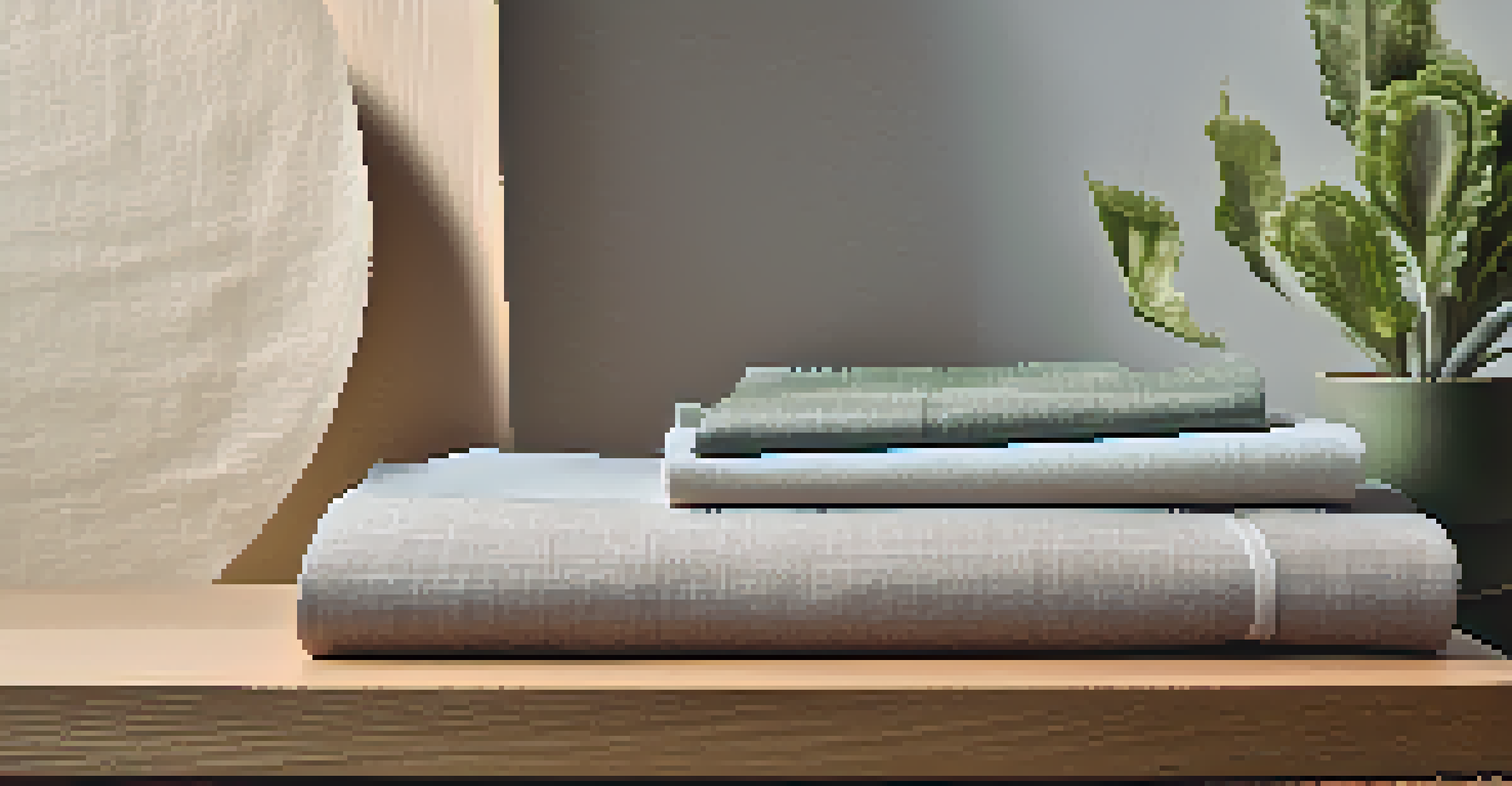The Future of Sustainable Fashion: Plant-Based Innovations

Understanding Sustainable Fashion and Its Importance
Sustainable fashion is not just a trend; it's a necessity for our planet's future. As the fashion industry is a significant contributor to pollution and waste, moving towards more sustainable practices can have a profound impact. By focusing on eco-friendly materials and ethical production methods, we can help reduce our carbon footprint and preserve natural resources.
Fashion is the armor to survive the reality of everyday life.
At its core, sustainable fashion aims to create clothing that is environmentally friendly, socially responsible, and economically viable. This means supporting fair labor practices and ensuring that the materials used are sourced sustainably. It's about rethinking the entire lifecycle of a garment, from production to end-of-life disposal.
As consumers become more aware of the environmental impact of their choices, the demand for sustainable fashion continues to grow. This shift is pushing brands to innovate and adopt practices that prioritize the planet's health, paving the way for a more sustainable future in the fashion industry.
The Role of Plant-Based Materials in Fashion
Plant-based materials are revolutionizing the fashion industry, offering sustainable alternatives to traditional textiles. Fabrics like organic cotton, hemp, and linen are not only biodegradable but also require fewer resources to produce. These materials often have a lower environmental impact, making them ideal choices for eco-conscious consumers.

In addition to traditional plant-based fabrics, innovations such as mushroom leather and pineapple fiber are gaining traction. These materials not only mimic the look and feel of leather but also provide a sustainable alternative that reduces reliance on animal products. This opens up exciting possibilities for designers looking to create stylish and eco-friendly clothing.
Sustainable Fashion is Essential
The fashion industry must adopt sustainable practices to combat pollution and waste, ensuring a healthier planet for future generations.
By embracing plant-based materials, fashion brands can significantly reduce their environmental footprint. As more companies invest in research and development to explore new plant-based innovations, the future of sustainable fashion looks promising, blending style with sustainability.
Innovative Plant-Based Textiles: A Closer Look
Some innovative plant-based textiles are already making waves in the industry. For instance, Tencel, made from sustainably sourced wood pulp, is known for its softness and breathability. Not only is it biodegradable, but its production process uses less water and energy compared to conventional fabrics, showcasing a win-win for both consumers and the environment.
Sustainability is no longer about doing less harm. It's about doing more good.
Another noteworthy innovation is Piñatex, a leather alternative made from pineapple leaf fibers. This unique material not only provides an eco-friendly option for footwear and accessories but also supports local farmers by adding value to agricultural waste. Such innovations highlight the potential of plant-based textiles to create sustainable solutions in fashion.
As these materials gain popularity, we can expect more designers to incorporate them into their collections. This shift not only caters to the growing demand for sustainable products but also encourages a culture of creativity and innovation in the fashion industry.
The Shift Towards Ethical Production Practices
Sustainable fashion is not solely about materials; ethical production practices play a crucial role as well. Brands are increasingly focusing on transparency in their supply chains, ensuring that workers are treated fairly and paid livable wages. This commitment to ethical practices fosters trust and loyalty among consumers who value social responsibility.
Additionally, many brands are adopting local production methods to reduce their carbon footprint. By manufacturing closer to their consumer base, they can minimize transportation emissions and support local economies. This shift not only benefits the environment but also encourages sustainable job creation.
Consumer Demand Drives Change
Increased consumer awareness and advocacy for sustainable choices are pushing brands to prioritize ethical practices and eco-friendly materials.
As consumers demand more accountability from fashion brands, the pressure to adopt ethical practices will only increase. This emerging trend helps create a fashion landscape that values both people and the planet, aligning with the principles of sustainable fashion.
Consumer Demand: Driving Change in Fashion
Consumer awareness is a powerful force driving change in the fashion industry. With increased access to information, shoppers are more informed about the environmental and social impacts of their purchases. This has led to a rise in demand for sustainable and ethically produced clothing, prompting brands to rethink their practices.
Social media plays a significant role in amplifying this demand. With influencers and activists promoting sustainable fashion, consumers are encouraged to choose brands that align with their values. This growing community of eco-conscious shoppers is reshaping the industry, making sustainability a priority.
As consumers continue to advocate for change, brands that embrace sustainable practices will likely thrive. The future of fashion hinges on this collective effort to prioritize the environment, leading to a more sustainable industry overall.
The Role of Technology in Sustainable Fashion Innovations
Technology is at the forefront of driving sustainable fashion innovations. From 3D printing to digital fashion design, advancements are enabling brands to create clothing with minimal waste. This not only helps reduce the environmental impact but also allows for more personalized and unique designs.
Moreover, tech solutions like blockchain are enhancing transparency in supply chains. By providing consumers with traceability, brands can demonstrate their commitment to ethical practices. This transparency builds trust and empowers consumers to make informed choices about the products they buy.
Technology Fuels Innovations
Advancements in technology, such as 3D printing and blockchain, are enabling sustainable fashion innovations and enhancing transparency in supply chains.
As technology continues to evolve, we can expect even more breakthroughs in sustainable fashion. The integration of innovative tools and techniques will play a vital role in shaping the future of the industry, making it more sustainable and accessible.
Challenges Facing Sustainable Fashion Initiatives
Despite the progress being made, sustainable fashion initiatives face several challenges. One major hurdle is the cost associated with sourcing sustainable materials and implementing ethical practices. Many consumers still prioritize low prices over sustainability, which can make it difficult for brands to compete.
Additionally, there is often a lack of awareness about sustainable fashion among consumers. While interest is growing, not everyone understands the importance of making conscious choices. Brands must invest in education and outreach to inform consumers about the benefits of sustainable fashion.

Finally, the fashion industry's fast-paced nature can hinder sustainable initiatives. The pressure to produce new collections quickly can lead to compromises in sustainability practices. Addressing these challenges requires collaboration and commitment from all stakeholders in the industry.
The Path Forward: Collaborations and Innovations
The future of sustainable fashion lies in collaboration and innovation. By working together, brands, designers, and consumers can create a more sustainable fashion landscape. Partnerships between fashion companies and environmental organizations can lead to groundbreaking initiatives that prioritize the planet’s health.
Moreover, innovative approaches to recycling and upcycling can extend the lifecycle of garments. Brands that embrace circular fashion – where products are designed with reuse in mind – will play a crucial role in reducing waste and conserving resources. This shift toward a circular economy is essential for achieving long-term sustainability.
As we move forward, fostering a culture of collaboration and innovation will be key to overcoming challenges and driving meaningful change in the fashion industry. Together, we can create a future where fashion is not only stylish but also sustainable.